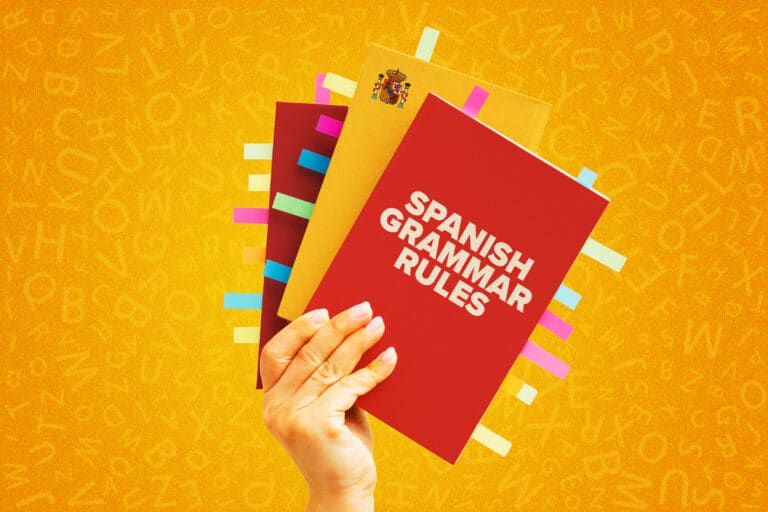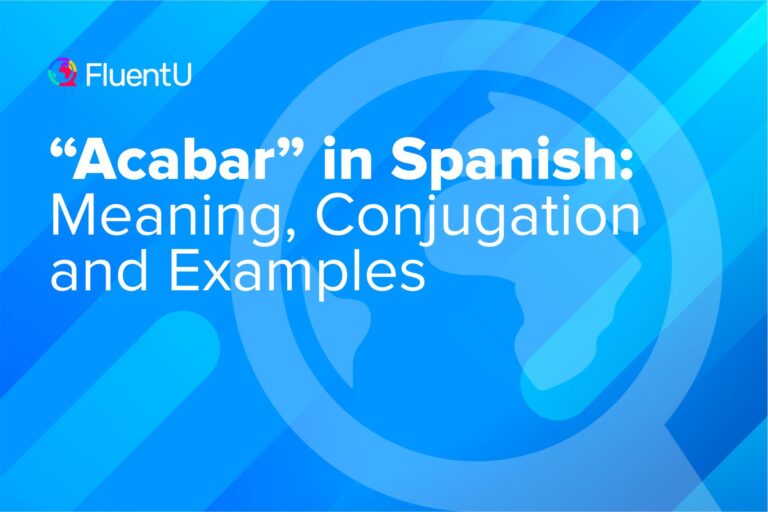7 Advanced Spanish Grammar Concepts

Imagine being able to master advanced Spanish grammar to the point where you feel confident carrying out seemingly impossible feats of Spanish grammar. It’s even possible to speak Spanish like a native speaker, if you just dedicate some time every day toward this goal.
I’m here to teach you some advanced Spanish grammar tricks and have you on your way to becoming a Spanish grammar master. These mini-lessons will help you tackle some of the trickier aspects of grammar with more ease, such as the personal a, uses of the infinitive and more.
Download: This blog post is available as a convenient and portable PDF that you can take anywhere. Click here to get a copy. (Download)
1. Comparison With a Number and a Clause
Comparison in Spanish is easy, right?
You use más/menos…que and you are ready to go:
Tengo más libros que Teresa. (I have more books than Teresa.)
But what happens when you want to compare a number? Have a look at the following sentence, which is an example of a very common mistake among students of Spanish:
Había más que 9 personas en la cola. (There were more than 9 people in the line.)
It may seem this sentence has everything it needs in order to be correct, but it doesn’t!
When dealing with comparisons with a number, forget about que and use de instead!
Había más de 9 personas en la cola.
Estuve esperando que volviera más de 3 meses. (I was waiting for him to come back for more than 3 months.)
And now comes the funny part.
You can say no más que + [number], meaning “only [number].”
However, although no más que and no más de may have a quite similar meaning, there is definitely a difference between them, so try not to mix them up!
No quiero tener más que un hijo. (I only want to have one child.)
No quiero tener más de un hijo. (I don’t want to have more than one child.)
No necesito más que 5 huevos. (I only need 5 eggs.)
No necesito más de 5 huevos. (I don’t need more than 5 eggs.)
No tengo más que 50 euros. (I only have 50 euros.)
No tengo más de 50 euros. (I don’t have more than 50 euros.)
When it comes to comparing with a clause, what we need to bear in mind is whether we have a noun or pronoun to compare or not.
If we have one, just use más/menos + del/de la/de los/de las + que, depending on the noun you are referring to:
Tengo más dinero del que necesito. (I have more money than I need.)
Corro menos kilómetros de los que solía correr antes. (I run fewer kilometers now than I used to.)
If you don’t have any noun or pronoun to compare, use más/menos de lo que:
Eres más alto de lo que pensaba. (You are taller than I thought.)
Estoy más cansado de lo que imaginas. (I am more tired than you imagine.)
Easy!
2. Feelings and Tener Expressions
Have you ever gotten into trouble because you said “estoy caliente” instead of “tengo calor” (see below)?
Don’t worry! This is a very common error among learners of Spanish.
In Spanish, we like to “have” a feeling rather than “being” it. Just remember to use tener in front of this kind of expression and you will not have to feel embarrassed anymore.
The most common tener expressions are…
- Tener calor (to be hot):
Ayer tuve mucho calor. (I was very hot yesterday.)
- Tener cuidado (to be careful):
Ten cuidado con lo que deseas. (Be careful what you wish for.)
- Tener experiencia (to be experienced):
Tom tiene experiencia en la venta de televisores. (Tom is experienced in selling TVs.)
- Tener frío (to be cold):
¿De verdad tienes frío? (Are you really cold?)
- Tener hambre (to be hungry):
Al volver a casa tenía mucha hambre. (He was very hungry when he came back home.)
- Tener miedo (to be afraid):
Tengo miedo a las arañas. (I am afraid of spiders.)
- Tener prisa (to be in a hurry):
Por favor, haz la compra que yo tengo prisa. (Please, do the shopping. I am in a hurry.)
- Tener razón (to be right):
Creo que ella tiene razón porque aún no hemos recibido nada. (I think she is right because we haven’t received anything yet.)
- Tener sed (to be thirsty):
Yo nunca tengo sed. (I am never thirsty.)
- Tener sueño (to be sleepy):
Siempre tengo mucho sueño después de almorzar. (I am always very sleepy after lunch.)
3. The Imperative with Object and Reflexive Pronouns
Reflexive and object pronouns are added to the end of the imperative form when we have a positive imperative. This shouldn’t be difficult for an advanced learner to grasp, since we have seen this already happening in infinitives and gerunds.
Bear in mind that we normally keep the accent in the same place after adding the pronoun or pronouns, so you will have to add an accent mark if the final word needs it.
Have a look at some examples:
- Come (Eat!) → Cómelo (Eat it!)
- Besa (Kiss!) → Bésala (Kiss her!)
- Da (Give!) → Dámelo (Give it to me!)
If we need to add two pronouns, remember the rule IO — DO (Indirect Object — Direct Object), or as we colloquially say in Spanish, Primero las personas y luego las cosas (People first, then things):
- Devuelve → Devuélveme → Devuélvemelo (Give it back to me!)
- Explica → Explícale → Explícaselo* (Explain it to him.)
- Enviemos → Enviémosle → Enviémoselas* (Let’s send them to him.)
*Remember that pronouns le and les become se when they have a second pronoun after them.
Another thing to take into account is the fact that in reflexive verbs, the vosotros imperative loses its final –d before adding the ending –os:
- Afeitarse (to shave) → Afeitad → Afeitaos
- Ducharse (to shower) → Duchad → Duchaos
- Levantarse (to get up) → Levantad → Levantaos
There is only one exception to this rule! The verb ir (to go) keeps the –d: ¡Idos!
When we have a negative imperative, the pronouns precede it. Remember that the le → se rule also applies here:
- No comas (Don’t eat!)
- No lo comas (Don’t eat it!)
- No le des (Don’t give to her!)
- No se lo des (Don’t give it to her!)
4. Uses of the Infinitive
Infinitives can fulfill many different functions both in Spanish and English. However, we Spaniards love to use our infinitives probably as much as English speakers love to use their gerunds (just kidding!).
Here you have some of the most important uses of the infinitive in Spanish.
a. We use infinitives after adjectives.
Es imposible saber la verdad. (It is impossible to know the truth.)
Es bonito ver el atardecer contigo. (It is beautiful to see the sunset with you.)
Considero interesante leer ensayos. (I consider it interesting to read essays.)
b. We use the infinitive as a noun in Spanish.
It happens that in English you would use an –ing form in these cases:
Me gusta correr. (I like running.)
Fumar es malo para la salud. (Smoking is bad for your health.)
Detestamos comer pizza. (We hate eating pizza.)
c. When we have two verbs one after another, the second one will always be in its infinitive form.
Two examples of this can be found above. Here you have some more:
Quiero comprar un coche. (I want to buy a car.)
¿Te apetece ir al cine? (Do you feel like going to the cinema?)
No necesito estudiar más. (I don’t need to study more.)
d. We use infinitives after prepositions.
Fui a España para visitar a mi familia. (I went to Spain in order to visit my family.)
Sueña con volar. (He dreams of flying.)
Acabo de terminar de trabajar. (I have just finished working.)
e. We normally use the infinitive with instructions (especially in recipes) and warnings.
Añadir el azúcar y mezclar. (Add the sugar and mix.)
No tocar. (Don’t touch.)
Manipular con cuidado. (Handle with care.)
5. The Personal A
The Spanish preposition a has a lot of uses and tends to be one of those prepositions that appear in many students’ nightmares. What a lot of learners don’t know is that, apart from its normal uses as a common preposition, a has another very important function: marking the personal object pronoun.
When our object or pronoun refers to a definite person or beloved animal, the preposition a precedes it:
Estoy buscando a mi hermana. (I am looking for my sister.)
Voy a darles de comer a las tortugas. (I am going to feed the turtles.)
Esta mañana he visitado a mi abuela. (I visited grandma this morning.)
Notice this doesn’t happen if we have an indefinite object or thing:
Estoy buscando un profesor de francés. (I am looking for a French teacher.)
Voy a comer sopa. (I am going to eat some soup.)
Esta mañana he visitado un museo. (I visited a museum this morning.)
Necesito una novia. (I need a girlfriend.)
Also, use the personal a when alguien, nadie, algún (-o,-a, -os, -as), ningún (-o, -a, -os, -as) or quién function as direct objects:
Mi primo ha ido a visitar a alguien. (My cousin has gone to visit someone.)
No quiero ver a nadie. (I don’t want to see anybody.)
¿Has visto a alguno de los invitados? (Have you seen any of the guests?)
No, no he visto a ninguno. (No, I haven’t seen any of them.)
¿A quién llamas? (Who are you calling?)
And that’s it! Now you will not need a nadie correcting your mistakes!
6. Augmentatives, Diminutives and Pejoratives
Augmentatives, diminutives and pejoratives are formed by adding suffixes at the end of a word. There are many suffixes in Spanish that can be used in order to change the meaning of a word, but the following are the ones most often used.
Augmentatives
Augmentative suffixes often make the noun bigger. However, very often an augmentative suffix can be used to add a sense of gawkiness and clumsiness. The most common augmentative suffixes are:
- -ón/-ona
casa (house) → casona
- -azo/-aza
mueble (furniture) → mueblazo
- -udo/-uda
This is normally used with parts of the body as in cabezudo, or “large-headed.”
Diminutives
Diminutive suffixes are used for two main purposes. Firstly, we use diminutive suffixes to make the noun smaller.
Have a look at the most common ones:
- -ito/-ita
This is probably the most usual, as in:
casa → casita
plato (plate) → platito
libro (book) → librito
- -illo/-illa
pájaro (bird) → pajarillo
teléfono (telephone) → telefonillo
lente (lens) → lentilla
- -ín/-ina
pequeño (young/small) → pequeñín
pillo (mischievous, rascal) → pillín
- -ico/-ica
hombre (man) → hombrecico
puerta (door) → puertica
mesa (table) → mesica
- -uelo/-uela
ladrón (thief, robber) → ladronzuelo
Secondly, we use diminutive suffixes to imply endearment:
Francisco → Francisquito
Papá → Papito/Papaíto
Hermano → Hermanillo
José → Joselín
Pejoratives
Pejoratives are used to imply grime, ugliness, etc. Spanish people are masters in creating pejoratives from almost any word. There are, however, a couple of suffixes that tend to appear more often than others. Have a look at them:
- -aco/-aca
libro → libraco
mueble → mueblaco
- -acho/-acha
hilo (thread) → hilacho
rico (rich man) → ricacho
- -ucho/-ucha
cama (bed) → camucha
cuarto (room) → cuartucho
- -ejo/-eja
palabra (word) → palabreja
calle (street) → calleja
And now take that libraco and go study!
7. Reflexive Verbs with Change in Meaning
Normally, the difference between a non-reflexive verb and its reflexive counterpart is nonexistent, or at least very, very slight. Some examples of this are:
- comer (to eat) → comerse
- beber (to drink) → beberse
- tomar (to take) → tomarse
- leer (to read) → leerse
Note: Generally, while the change in meaning may in fact be very slight, the reflexive form intensifies the meaning of the verb. For instance, in the first two examples above, the reflexive form can also mean to “eat up” or to “drink up.”
However, there are some verbs in Spanish that have different meanings (sometimes not related at all) depending on whether we are using them as reflexives or non-reflexives.
Writing down a complete list would be outside the time and space scope of this post, but there are some commonly used verbs worth mentioning:
- acostar (to put to bed) → acostarse (to go to bed)
- cambiar (to change) → cambiarse (to change clothes)
- dormir (to sleep) → dormirse (to fall asleep)
- encontrar (to find) → encontrarse (to be located)
- levantar (to lift up) → levantarse (to get up, to stand up)
- llevar (to carry) → llevarse (to take)
- negar (to deny) → negarse (to refuse to)
- parecer (to seem like) → parecerse (to look physically like)
- perder (to lose) → perderse (to get lost)
- referir (to refer) → referirse (to concern)
- reunir (to collect) → reunirse (to assemble)
I hope that no te has dormido reading this post!
As you can see, you just need some 10 minutes a day in order to learn something new with these mini-lessons.
Start using this technique on a day-to-day basis, and you will very soon realize you have been making excuses not to study, because it is not simply a matter of time.
Hope you enjoyed the post. See you soon!
Download: This blog post is available as a convenient and portable PDF that you can take anywhere. Click here to get a copy. (Download)
And One More Thing…
If you've made it this far that means you probably enjoy learning Spanish with engaging material and will then love FluentU.
Other sites use scripted content. FluentU uses a natural approach that helps you ease into the Spanish language and culture over time. You’ll learn Spanish as it’s actually spoken by real people.
FluentU has a wide variety of videos, as you can see here:

FluentU brings native videos within reach with interactive transcripts. You can tap on any word to look it up instantly. Every definition has examples that have been written to help you understand how the word is used. If you see an interesting word you don’t know, you can add it to a vocab list.

Review a complete interactive transcript under the Dialogue tab, and find words and phrases listed under Vocab.

Learn all the vocabulary in any video with FluentU’s robust learning engine. Swipe left or right to see more examples of the word you’re on.

The best part is that FluentU keeps track of the vocabulary that you’re learning, and gives you extra practice with difficult words. It'll even remind you when it’s time to review what you’ve learned. Every learner has a truly personalized experience, even if they’re learning with the same video.
Start using the FluentU website on your computer or tablet or, better yet, download the FluentU app from the iTunes or Google Play store. Click here to take advantage of our current sale! (Expires at the end of this month.)







